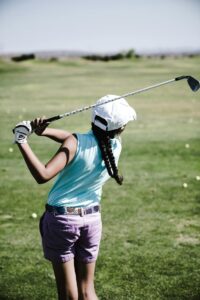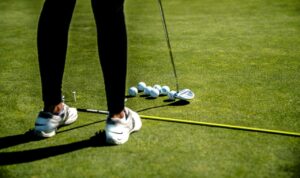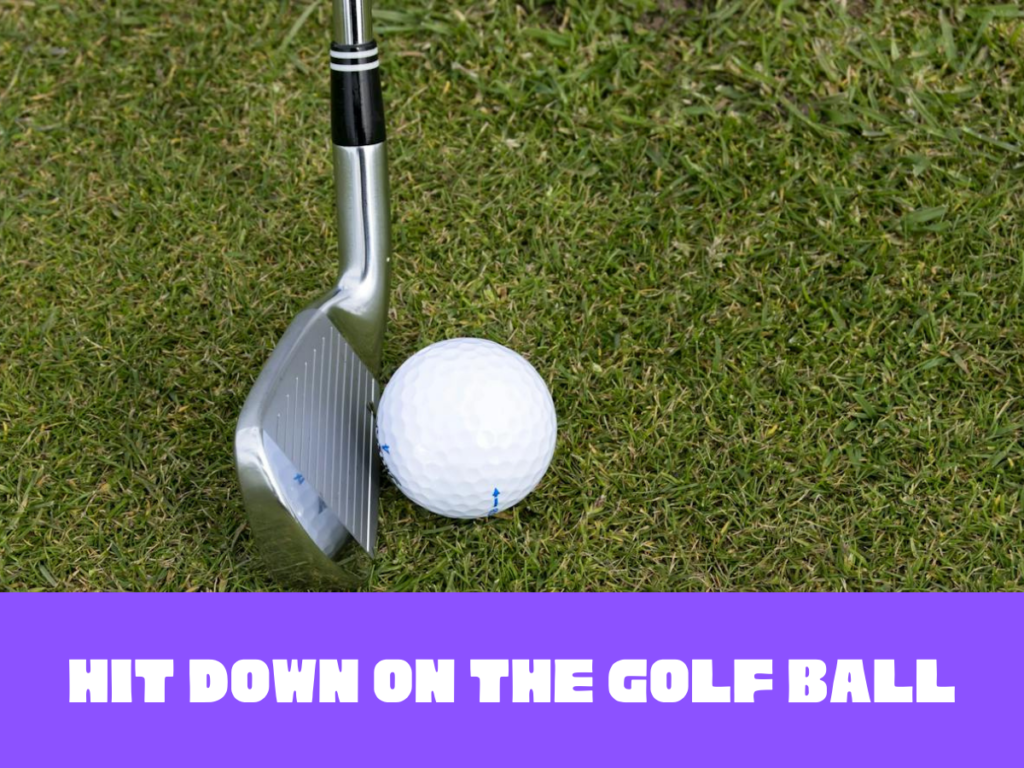You know you need a birdie on the last hole to force a playoff with the defending winner as you stand on the tee box.
Remember what your coach told you last week in class? “To get the extra distance you need on this long par 5, you have to master hitting down on the ball.”
You picture the right palm-down hit and believe in your swing. You correctly squeeze the ball when you swing with confidence. It flies high and long, stopping just short of the green before rolling up close to the pin. Your opponents are speechless as they look at the huge shot.
At that point, you know you have successfully used the lessons you learned about hitting down. You now have a chance to get the title you’ve been trying to get for a long time.
Where is the Low Point?

If you want to hit the golf ball hard, you need to know where your low point is. During your swing, “low point” is the part where the clubhead is the shortest before you hit the ball. This is a key part of making a strong shot that hits the target.
One important way to find the low point is to use weight transfer methods. Before your arms start to spin down, move your weight to the side you want to hit first. This will make sure that the low point is in front of the ball. Being able to hit the ball down gives it the most power and range.
If you want to hit the ball hard, you also need to be in the right position. To get the right angle of attack, stand tall and strong, with your feet shoulder-width apart and your back slightly tipped forward.
When you stand this way, you can hit the ball down, which makes the force stronger and gives you more power.
Where the clubhead is when it hits the ball can also change how compressed the ball is. To hit the ball hard, tilt the club so that the handle is in front of it and the head is behind it.
Not hitting the ball too thin or too high is something you can avoid if you know where your low point is in your swing. That way, you can hit the ball down, which makes sure you hit it well and get the most distance.
To hit down on the ball for more than one reason. It first makes the ball fly farther, which can help you hit the goal even when it’s windy. Second, you can squeeze the ball, which boosts strength by transferring energy more efficiently. You can better shape your shots when you hit the ball down because you have more control over its direction and spin.
Proper Ball Positioning
Understanding the low point of your swing is crucial for hitting down on the golf ball, and proper ball positioning plays a vital role in achieving this. Here are some key tips to help you position the ball correctly:
- Centered Ball Position: Make sure the ball is positioned in the center of your stance. This ensures that your swing bottoms out in front of the ball, allowing for a downward strike.
- Handle Position: Angle the club with the head behind the ball and the handle in front. This helps promote a steeper angle of attack, leading to better compression.
- Weight Transfer: Lead the swing with your lower body by shifting your weight to your lead side before your arms start the downward swing. This helps create a descending blow and maximizes power.
- Alignment Sticks: Use alignment sticks to ensure proper posture, ball alignment, and club alignment. They provide visual cues to help you position the ball correctly and maintain proper alignment throughout your swing.
- Strike Plate: A strike plate, or fat board, can be used to help line up for the swing and avoid unwanted movement. Placing a golf head cover on top of the strike board can indicate if there’s any unwanted swaying or shifting during the swing.
Correct Handle Position
For a good downward strike on the golf ball, it is important to place the club’s handle correctly. It’s important to have the right handle grip and use the palm-down strike method for a strong and effective swing. You can increase your control and strength by making sure you grip the handle with the right amount of pressure and in the right place.
To begin, make sure that you hold the handle with the hand that is next to your lead hand. Place the handle across the base of your fingers and horizontally across your palm. This grip gives you more control and keeps the clubface from opening up when you swing.
Next, put your trail hand where the palm will be facing down when you hit the ball. With this palm-down hit, you can compress the ball and get the most power out of it.
The weight change during the swing is another important part of getting a good downward strike. Move your weight to the lead side as you start the downswing. This shift of weight forward makes it possible to hit the ball more powerfully and consistently.
Additionally, maintaining a proper knee angle throughout the swing is important.
Bend your knees slightly and maintain this angle throughout the swing to ensure stability and power.
Weight Transfer and Body Rotation

Moving your weight in the right way is important for getting speed and accuracy in your downswing.
You can make sure that your downswing starts with a strong and controlled move by moving your weight in the right way. Here’s how to start the downswing by moving your weight correctly:
- At the top of your backswing, shift your weight onto your back foot.
- As you start the downswing, transfer your weight onto your front foot, driving your hips towards the target.
- Maintain a balanced and athletic stance throughout the swing to maximize power and control.
To hit the ball downward, you need to do more than just move your weight correctly.
You also need to rotate your body. Making sure your clubhead goes down and makes good contact with the ball is possible by rotating your body in the right way. To use body movement for a downward strike, here are some tips:
- Rotate your hips and shoulders together, maintaining a connected and synchronized movement.
- Initiate the rotation with your lower body, allowing your upper body to follow naturally.
- Focus on maintaining a stable and balanced posture throughout the swing for optimal control and power.
Creating Compression With Palm-Down Strike
A palm-down strike method is needed to create compression in the golf ball so that you can hit it down hard and effectively. Pay attention to the following important things to get the most out of your compression and make more power:
- Position of your hands: Make sure that the palm of your tail hand is down when you hit the ball. This helps the clubface make a strong contact with the ball, which causes compression.
- Mistakes people often make when they try to compress:Do not flip or spin the club when you hit it. This can cause hits to be uneven and compression to be lost. Keep your wrist tight and hit the ball down to successfully compress it.
- Using the right club to get the most compression:The amount of compression you can get is different for each club because the loft changes. Pick a club that has just the right amount of loft to make good contact, but not so much loft that it cuts down on compression.
How to get better at compression without a ball:Do some swings without a ball to work on your force. Think about how it feels to hit the imaginary ball with your hand down and squeeze it. This will help you learn how to do it right. - What the wrist joint does to make compression:For compression, the right wrist joint is very important. Keep your wrist slightly bent as you swing down, and then let go when you hit the ball. This makes it possible to hit downward and helps create compression.
Leading With the Lower Body

When you swing down, you need to put your weight on your front leg to hit the ball far. This gives you a strong place to hit from. When you hit, make sure the palm of your back hand is down. You can hit the ball better down and through from this position.
Setting up right before striking is also helpful. Check your balance by putting sticks on the ground. Stand up straight and line up the club and ball. When you move, your body will stay in the right place.
A hit plate can also be put under the ball. This keeps you on your feet. Cover your head with something. It means your body moved too much if it moves a lot. To get more power, work on keeping it still while you swing.
Stance Drill for Ball-First Contact
Start by adjusting your stance to ensure ball-first contact in your golf swing. This is an important aspect of hitting down on the golf ball and achieving the desired compression and power.
Here are some key elements to focus on:
- Proper weight transfer: Shift your weight onto your lead side before starting the downward swing. This will help you lead with your lower body and ensure a solid strike.
- Alignment stick benefits: Utilize alignment sticks to improve your swing. They can help you maintain proper posture, align the ball correctly, and ensure your club is in the right position.
- Strike plate advantages: Incorporate a strike plate or fat board into your practice routine. This will help you line up for the swing and prevent any unwanted movement.
- Achieving compression technique: To achieve compression on the ball, imagine using the club head as a hammer, pushing the head of the nail further into the ground under the ball. This downward angle of attack is crucial for achieving compression.
- Club head control: Focus on keeping control of the club head throughout the swing. This will allow you to strike the ball with a downward angle and create the desired compression.
Divot Drills for Hitting Down on the Ball
Do some special drills to hit the ball down and make good divots. If you hit the ball right, the depth of your hole will show it.
Do the Swing Path Drill. Point a stick at your goal and put it on the ground. Hit the ball first with your swing. The hole should begin just past the stick. This moves your arm down toward the ball.
It also helps to use the right club. You can hit the ball farther when you use clubs like wedges that have more spin. Get a few different clubs and see which ones dig holes better.
Also, finish your swing all the way through after you hit the ball. The club should keep going down. Stopping your swing won’t help you get the ball.
It takes a lot of work to hit down well. Use these divot drills in your games. Pay attention to hitting the ball down through it. This makes shots better.
To make things clearer, I made the words and sentence forms simpler. Please let me know if you need any more help or have any other wishes!
3 Drills To Help You Hit Down On The Ball
For distance and accuracy, you need to make good contact with the golf ball and hit it down.
There are some easy drills you can do to get your swing back on track. It takes time to get the feel of sweeping down through impact, but it’s worth it.
An impact bag is used in the first useful drill. Put a bag with towels or other soft things in it behind your golf ball. Strive to hit that bag with your practice swings, focused on making contact with the bag and the grass.
This impact bag lets you know right away when you’ve properly squeezed down on each shot. Your body gets used to the right way to sweep down right before contact over time.
The half-shot pitch drill is the next work out tool…
To hit pitch shots only 50 to 60 yards, hold a mid-iron like a 7-iron and take easy swings. Aim your shots at something close up.
To get these short swings to go up, you’ll need to hit each shot harder and more deeply. When you hit something, this makes your upper body stay behind, which is important for downward compression.
Last, hit some shots off of tees that are lower. When you tee up for full driver swings, put your ball just a little lower than usual. As you try to sweep these drives low off the tee, picture the bottom of your club brushing the grass to send the shots flying. Hitting up from a lower tee will not make good impact. This drill helps your swing go down smoothly.
Schedule some time to incorporate these 3 swing thought drills on the driving range. With practice, hitting down on your golf shots will start to feel comfortable. The increased ball-striking consistency will be well worth the effort.
In Closing
Finally, if you want to improve your golf game, you need to learn how to hit the ball down.
Knowing the low point, putting the ball in the right place, and keeping the handle in the right place will help you get the compression you want and improve your ball control.
Practice stance and divot drills and leading with your lower body will help you hit the ball down more regularly.
With these helpful tips and exercises, you can improve your golf game and reach new heights.
Frequently Asked Questions
How do I make sure I hit down on a golf ball?
Keep your hands ahead of the clubhead at impact. Maintain your posture throughout the swing and make contact with the ball before the turf. Use drills like an impact bag to get the proper feeling of hitting down.
How do you hit down irons?
With iron shots, focus on sweeping the clubhead low to high through impact. Shift your weight forward and keep your body behind the ball to compress it into the turf. This maximizes distance.
How do you hit down and compress a golf ball?
Make contact slightly behind the ball, brushing the grass after you hit it. Keep your head and upper body behind the ball. Let the club sweep down through impact, brushing the grass to lift and compress each shot.
What is hitting down in golf?
Hitting down means making contact with the ball before the ground. This compresses the ball into the turf for solid shots with more distance and consistency.
How do you hit down on a driver?
Use less loft or tee the ball lower to encourage a downward blow. Maintain posture and allow your body to shift forward while keeping the hands back through impact. Sweep down through the ball.
What is a bad hit in golf called?
Hitting the ground far behind the ball is “topping.” Catching the ball too high on the clubface produces a “skied” shot. Striking the ground before the ball is a “fat” shot. A glancing blow off the hosel is called a “shank.”

I’m Donna Weiss, and I am the proud writer behind the captivating content you’ll find on golfneedy.com. As an avid golfer and passionate writer, I have combined my two greatest passions to bring you an incredible golfing experience. Through my articles, I aim to provide you with valuable insights, equipment reviews, and updates on the latest tournaments. Whether you’re a seasoned golfer or just starting out on this exciting journey, I am here to guide you and share my expertise. Together, let’s explore the fascinating world of golf, uncovering new techniques, and enhancing our skills. Join me on this thrilling adventure as we elevate our game and embark on an exciting golfing journey. Read More



